Whare Ahuru Mowai — a future-focused library space
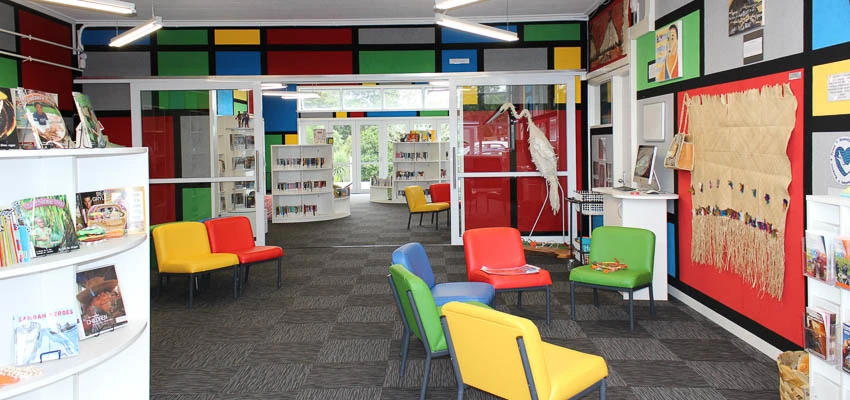
Collaboration was a key factor in developing Bailey Road's new library space. The result is a future-focused community space that showcases their unique story.
A new name
With the new focus moving away from their original, traditional-style library, the school decided the library needed a new name. They invited the community to share their ideas, and Whare Ahuru Mowai — meaning 'calm, sheltering place' — was the name chosen.
Welcome to our Whare Ahuru Mowai
When you step into Bailey Road’s Whare Ahuru Mowai, you're immediately struck by the bright, open, and welcoming environment. Pausing in the doorway as you enter, your eye is drawn through to the other end of the room and the outdoor presentation space. This has a fantastic view of the waharoa (entrance) to their nature trail and Pasifika fale.
A flexible, community space
As Jody Hayes, Deputy Principal, explains:
This is a flexible, community space, and ‘library’ is only part of what it offers. It is still a library, still used as a library, and then some — it is catering for the future. The hardest thing to do — it sounds so easy, but it’s really hard — is to make a flexible space.
Bailey Road’s key plan was to create a community space that was enticing to students and family alike, and a place where children actively interacted. They wanted their space to speak for itself and celebrate their unique story as a school, and their place in the world.
To make this a truly flexible space, the shelving is easy to move. In less than 5 minutes, the entire floor space can be cleared, allowing room for large groups to gather.
A team effort
The whole journey of building this facility has been a real team effort — not just one person’s dream. You can see the community's input in the way that the space incorporates family stories from the past and their dreams for the future.
3 parts to Whare Ahuru Mowai’s story
Whare Ahuru Mowai tells its story in 3 parts:
us as a school
us as the world
the imaginary world — the world of books and beyond our world.
This story is quite visible in the way the space is laid out.
Us as a school
Whare Ahuru Mowai’s first space shows:
the importance of the school community and their place in the greater Auckland city
the value Bailey Road School places on family/whānau, and
the outside relationships that they have formed.
Colours used
The colours reflect their school houses (blue/Kiwi, green/Kea, yellow/Tui and red/Weka). The grey acknowledges their relationship to HMNZS Te Kaha, the frigate they are affiliated with.
The Kōtuku in the corner is a physical representation of the image at the 'HEART' of their school logo. HEART in the logo stands for Honesty, Empathy, Affirmation, Respect, and Trust.
Gazing at the walls is like looking at a Mondrian painting — a deliberate effect achieved using the skill, creativity, and collaboration of the walling team. Jody explains that they wanted to be able to display different works of art, with the background wall providing borders for the works.
Find out about Piet Mondrian, the Dutch painter.
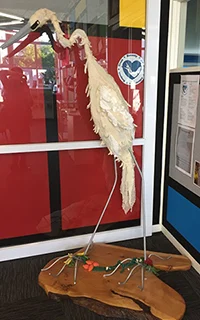
The Kōtuku bird
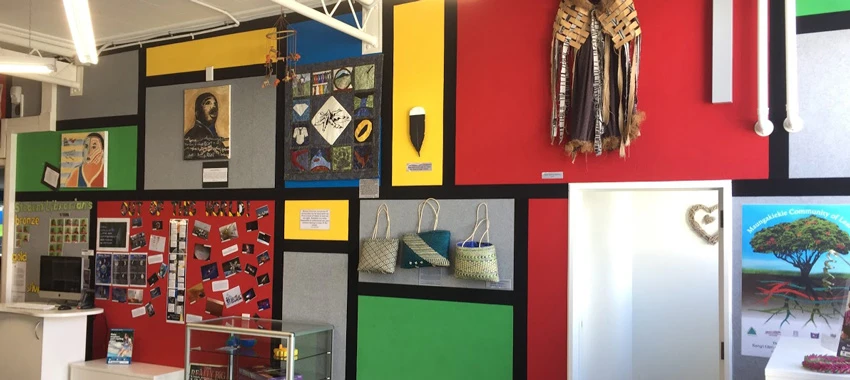
The walls are like one large piece of Mondrian artwork.
A welcoming and inclusive space with great resources
The first space is a welcoming and inclusive area for whānau and the community to relax before or during school. There's a variety of seating where they can read or talk with their children. It has a kitchenette area, wifi access, and various formats and styles of books to share.
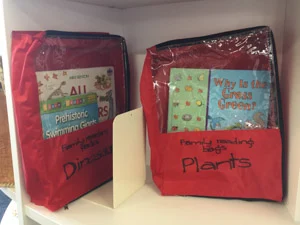
Whānau reading bags.
A key part of the ‘us as a school’ space is the wide-ranging collection of resources on the community/whānau shelves. These include a selection of community and health pamphlets, similar to what you can find in public libraries.
The collection also features the extremely popular ‘whānau reading bags’ — 84 of them at last count — which families can borrow without issuing. Jody explains that the reading bags are based on the 'curiosity kits' used in a research project by Maureen Lewis and Ros Fisher in 1998.
The school's variation contains a selection of books to entice families to read around a specific topic together.
Space for non-fiction, National Library books, and teacher tools
This section houses the library's Māori and Pacifica collection, which is being added to as the school's cultural community changes. It also contains the library's non-fiction collection, along with their National Library books, to make sure these books are easy to access.
One of the tools the library provides for teachers is the library skills kits. These kits provide an overview and list of resources for teachers to unpack during their planning sessions. The kits ensure that teaching 'traditional' library skills are included in the everyday busyness of the curriculum.
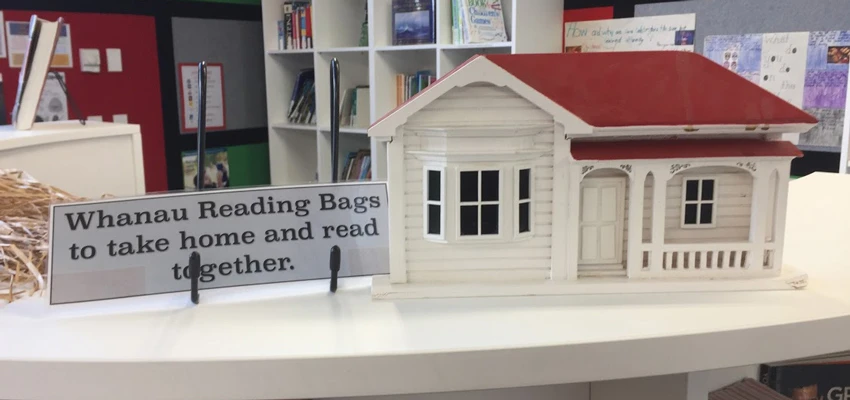
The community resources shelf-topper.
Us as the world
The second space in the journey represents Aotearoa New Zealand’s place in the world.
A shared experience with reading nooks
At Bailey Road, a class visit to Whare Ahuru Mowai is a shared experience. Classes come with their younger/older buddy class, giving them an opportunity to:
share their reading and writing
have conversations, and
help each other with issuing or returning books.
Student librarians are reading role models and are on hand to help choose books or read-aloud.
The cosy reading nooks were created after students asked for spaces to sit and read with their mates. These are actually reinforced with a lot of steel, making them an extremely safe structure for multiple students to enjoy. The unique shape of the shelving also creates lots of other spaces for students to escape into their own little world.
Shelving the fiction collection
The 'us as the world' space houses the fiction collection. Bailey Road has arranged and shelved this collection to encourage students to interact across different age groups and reading abilities.
This collection is shelved over multiple levels:
the lower levels hold the picture book collection/'younger buddy' books
the upper shelves hold the chapter books or 'older buddy' books.
Bailey Road also decided to move away from the traditional approach of separating fiction collections. The library still has spaces where they highlight particular authors or themes. But they have arranged most their fiction to encourage students to read a range of book types and “not be stuck in traditional expectations as to what they ‘should’ read.”
Wordless picture books
One other collection you can find in this second space is the wordless picture books. These are another great resource that whānau come in and share. No matter what language they speak or read, there's always something in this collection that families can talk about with their children.
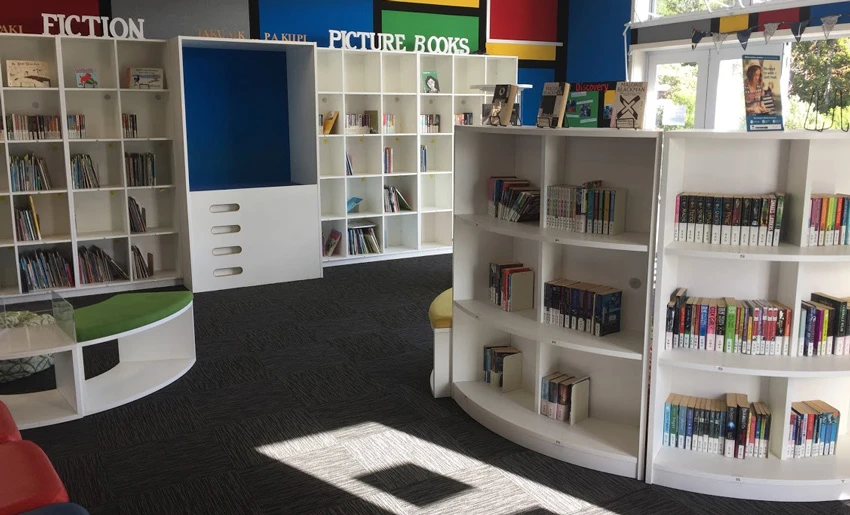
The reading nooks were created after students asked for spaces to sit and read with their mates.
World of books and beyond
The third and final space in Whare Ahuru Mowai is the expansive outdoor deck area. This space represents both the imaginary world of books and the global world beyond. Jody explains that this is a place of “emptiness and potential, rather than one filled up with things.”
Students see this as a key part of Whare Ahuru Mowai. They seamlessly move from indoors to outdoors, using it as an extension of the reading space. It also makes a perfect stage area for outdoor presentations.
The step-style seating and grassy area, perfect for picnics, add to the appeal and whole aspect of including the wider school community in life at Bailey Road.

A room with a view — the 'world of books and beyond' — a fantastic presentation space with infinite possibilities!